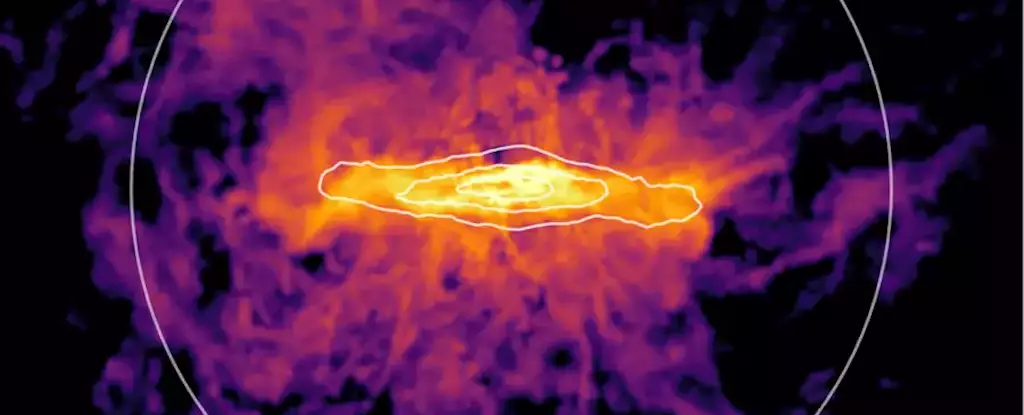In the grand tapestry of the universe, the elements that compose our very beings share a fascinating story that stretches across the cosmos. The notion that “we are made of star-stuff,” popularized by the renowned astrophysicist Carl Sagan, takes on a deeper significance when we consider the new research from the Hubble Space Telescope. This study reveals that the carbon atoms in our bodies may have embarked on a journey spanning hundreds of thousands of light-years, traversing not only the depths of our galaxy but extending beyond it into the circumgalactic medium—a vast cloud of gas encircling galaxies.
The process of elemental formation begins at the heart of stars, where nuclear fusion occurs under extreme pressure and temperature. Lighter elements, primarily hydrogen and helium, undergo fusion to create heavier elements, including carbon, which ultimately are released into space when these stars meet their explosive end in supernova events. This remnant material doesn’t simply dissipate; instead, it contributes to the birth of new stars, planets, and even life forms, creating a dynamic cycle of stellar birth and rebirth. The study from the Hubble team paints a broader picture of this cycle, indicating that carbon can escape the confines of our galaxies altogether before being reabsorbed, enriching the stellar nursery for future generations of stars.
Jessica Werk, an astronomer from the University of Washington, emphasizes the profound implications for our understanding of galaxy evolution. In their study, researchers analyzed the circumgalactic medium (CGM) of eleven star-forming galaxies, detecting carbon stretches a staggering distance—up to 391,000 light-years from its original galaxy. To put this into context, the extent of the Milky Way’s visible disk barely extends 100,000 light-years. This discovery transforms our comprehension of how elemental materials circulate throughout the universe, pushing the boundaries of what we thought we knew about galactic dynamics.
Samantha Garza, the lead author of the study, likens the circumgalactic medium to a giant train station that continuously dispatches and receives material. The elements expelled during supernovae are caught in the CGM’s grasp, only to return to their celestial origins, perpetuating the cycle of formation. This detailed observational technique utilized Hubble’s Cosmic Origins Spectrograph, leveraging light from nine distant quasars to reveal the unique spectral signatures of carbon. By analyzing these spectra, the researchers uncovered enough carbon mass to equal approximately three million suns—an astonishing figure that highlights the vast reservoirs of material present in the CGM.
The Distinctions of Star-Forming Galaxies
Interestingly, not every galaxy participates in this cosmic recycling journey equally. For galaxies actively engaged in star formation, a greater abundance of carbon and other elements has been observed compared to their passive counterparts. Previous studies suggested a similar trend with oxygen, further underscoring the dynamic interplay between forming stars and their circumgalactic environments. The data now confirms that star-forming galaxies harbor a rich reservoir of both carbon and oxygen, vital components for further cosmic material recycling.
The Implications for Galactic Evolution
Investigating these galactic cycles offers astronomers critical insights into the mechanisms behind star formation and the factors that lead galaxies to transition between active and passive states. Understanding the dynamics of the CGM also sheds light on the processes that transpire during galaxy mergers, a fate that our own Milky Way is expected to experience in the future. In contemplating the vast, invisible cloud of gas surrounding us, we recognize the potential for ongoing elemental migration already underway within our galaxy.
This enriches our comprehension of our existence, where the very atoms of our bodies have traversed unimaginable distances through time and space. Sagan’s elegant phrase becomes even more poignant: the “star-stuff” that constitutes our being did not just settle into position on Earth; rather, it journeyed through a cosmic odyssey, shaping itself through the intricate processes of galactic evolution. The realization that we share a lineage with the universe deepens our connection to the stars, underscoring the narrative of existence that interlinks the cosmos with life on our own planet.
As we continue to unravel the complexities of the universe and our place within it, the insights garnered from this research underscore the importance of recognizing our celestial heritage. The journey of carbon not only reveals the interconnectivity of cosmic elements but also inspires a deeper appreciation for the universe that gave rise to our very existence.


Leave a Reply